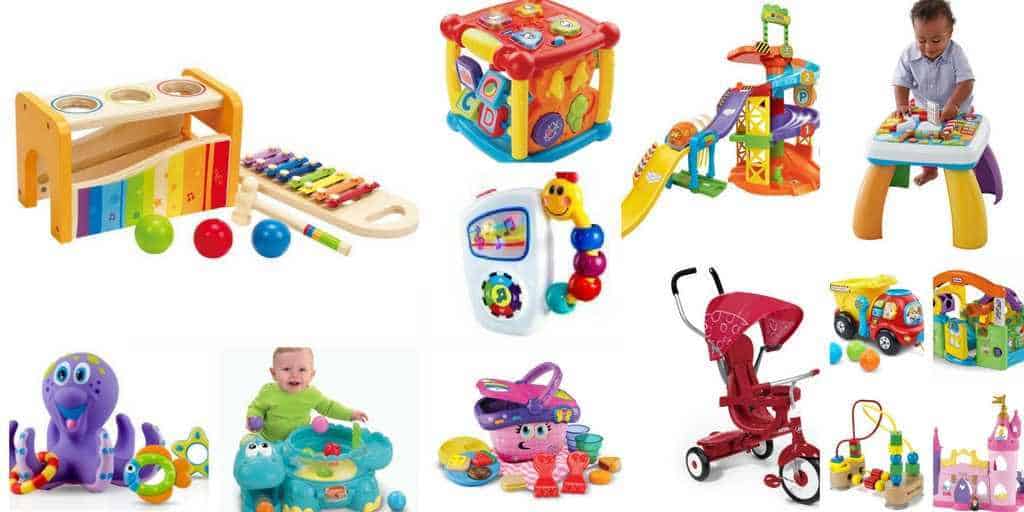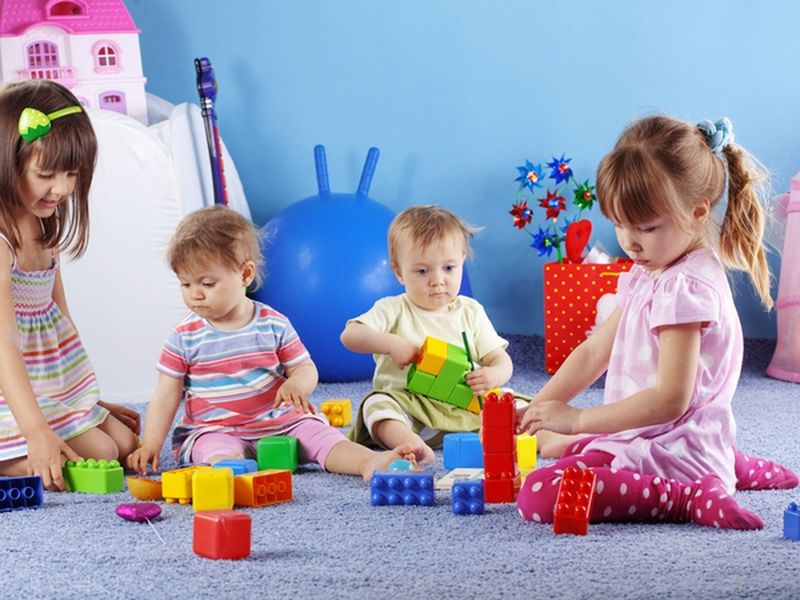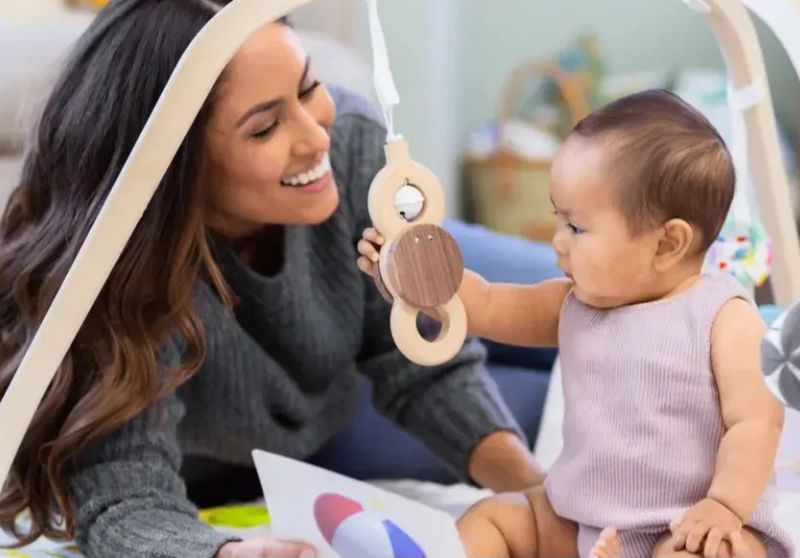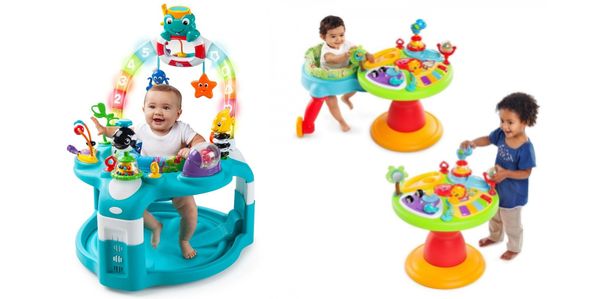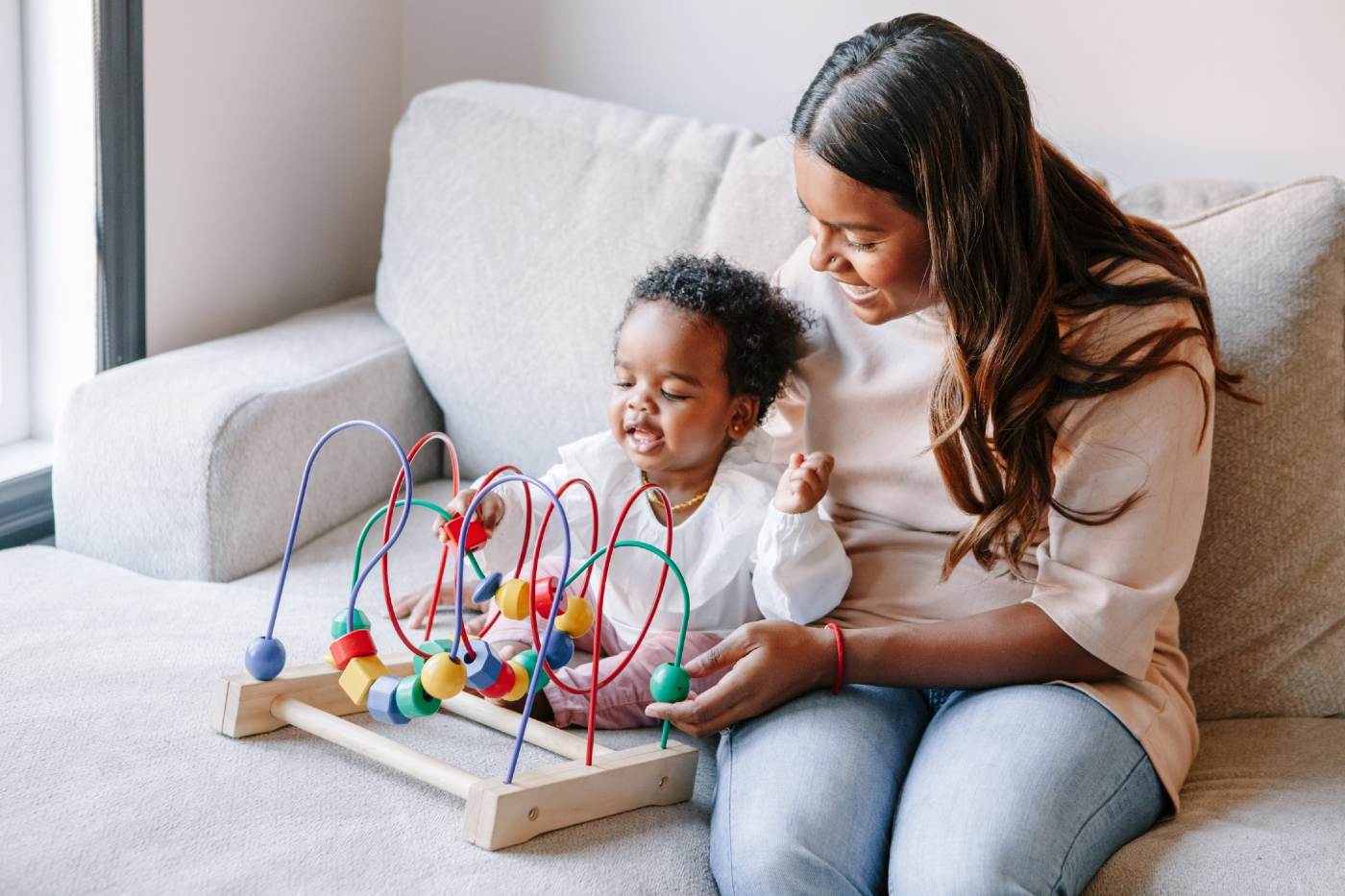
Exploring the Benefits of Baby Activity Toys in Infant Care
As a parent in the UK, you’re undoubtedly committed to giving your little one the best start in life. One of the most effective ways to support your baby’s development is through the use of activity toys. These cleverly designed playthings offer a wealth of benefits for your infant’s growth and well-being.
In this comprehensive guide, we’ll delve deep into the numerous advantages of incorporating baby activity toys into your child’s daily routine, providing you with expert insights and practical tips along the way.
The Importance of Stimulation in Early Development
Before we explore the specific benefits of baby activity toys, it’s crucial to understand why stimulation is so vital for infants. In the first few years of life, your baby’s brain is developing at an astonishing rate, forming millions of neural connections every day. This period, often referred to as the ‘critical period’, is when your child is most receptive to learning and sensory experiences.
During this time, every interaction, every sound, every texture your baby encounters helps shape their developing brain. It’s like building a house – the stronger the foundation, the more robust the structure will be. Baby activity toys play a vital role in providing the stimulation needed to support this rapid development. They offer a variety of sensory experiences, helping to engage your baby’s senses and encourage exploration of their environment.
Consider this: when your baby reaches out to grasp a colourful rattle, they’re not just playing – they’re learning about cause and effect, developing hand-eye coordination, and exploring different textures and sounds. Each of these experiences creates new neural pathways in your baby’s brain, setting the stage for future learning and development.
Cognitive Development: Boosting Brain Power
One of the primary benefits of baby activity toys is their ability to enhance cognitive development. These toys are designed to challenge your little one’s mind in age-appropriate ways, fostering crucial skills that will serve them well throughout their lives.
Problem-solving Skills
Many baby activity toys feature simple puzzles or cause-and-effect elements. For instance, a toy that lights up or plays music when a button is pressed helps your baby understand the concept of cause and effect. This understanding is a fundamental building block for problem-solving skills.
As your baby grows, you might introduce more complex toys, like shape sorters. These toys challenge your little one to figure out which shapes fit into which holes, promoting logical thinking and spatial awareness. When your baby successfully fits a shape into its corresponding hole, they’re not just playing – they’re solving a problem, and that success encourages them to tackle new challenges.
Memory and Recognition
Toys with different shapes, colours, and textures help develop your baby’s memory and recognition skills. As they interact with these toys repeatedly, they begin to remember and recognise specific features, enhancing their cognitive abilities.
For example, a soft book with different textures on each page helps your baby associate certain feelings with particular images. They might learn that the page with the fluffy cloud always feels soft, while the page with the shiny sun is smooth. Over time, they’ll start to anticipate these sensations before they even touch the page, demonstrating their growing memory skills.
Spatial Awareness
Activity gyms and playmats with dangling toys encourage your baby to reach out and grasp, helping them develop spatial awareness. This skill is crucial for understanding their body’s position in relation to objects around them.
As your baby bats at a hanging toy, they’re learning about distance and their own ability to affect objects in their environment. This spatial awareness will be crucial as they start to crawl and walk, helping them navigate their surroundings safely.
Concentration and Focus
Engaging with activity toys can help improve your baby’s attention span. As they become absorbed in play, they’re practising the skill of focusing on a task, which will be invaluable as they grow older.
You might notice your baby spending longer periods examining a particular toy or trying to achieve a specific goal, like making a toy produce a certain sound. This focused attention is laying the groundwork for future learning and academic success.
Physical Development: Encouraging Movement and Coordination
Baby activity toys aren’t just about mental stimulation; they also play a significant role in physical development. From strengthening muscles to refining motor skills, these toys provide countless opportunities for physical growth.
Fine Motor Skills
Toys with different textures, shapes, and sizes encourage your baby to grasp, hold, and manipulate objects. This helps develop their fine motor skills, which are essential for tasks like feeding themselves and, later, writing.
For instance, a simple set of stacking cups can provide a wealth of fine motor practice. As your baby learns to pick up the cups, turn them over, and eventually stack them, they’re developing the precise control of their fingers and hands that they’ll need for more complex tasks in the future.
Gross Motor Skills
Activity gyms and larger toys encourage your baby to reach, roll, and eventually crawl towards them. This helps develop their gross motor skills, strengthening their muscles and improving coordination.
A play gym with hanging toys at different heights encourages your baby to reach in various directions, promoting flexibility and strengthening core muscles. As they grow, they might push up during tummy time to get a better view of a toy, or roll over to reach something interesting, all of which contribute to their gross motor development.
Hand-eye Coordination
Many baby activity toys require your little one to coordinate what they see with their hand movements. For example, reaching for a dangling toy or putting a shape into a sorter helps refine their hand-eye coordination.
This skill is crucial for many everyday tasks. As your baby grows, improved hand-eye coordination will help them with activities like feeding themselves, drawing, and eventually writing.
Sensory Development: A World of Exploration
Baby activity toys are a treasure trove of sensory experiences, helping your little one make sense of the world around them. Each toy offers opportunities for your baby to engage their senses in new and exciting ways.
Visual Stimulation
Brightly coloured toys, contrasting patterns, and moving parts all provide visual stimulation. This helps develop your baby’s ability to focus, track moving objects, and distinguish between different colours and shapes.
For example, a mobile hanging over the cot with high-contrast black and white patterns can captivate a newborn, helping to develop their visual tracking skills. As they grow, toys with various colours and patterns continue to stimulate visual development.
Auditory Development
Toys that make sounds, whether it’s a gentle rattle or a musical tune, help develop your baby’s auditory skills. They learn to associate certain sounds with specific actions, enhancing their understanding of cause and effect.
A simple rattle can be a powerful tool for auditory development. As your baby shakes the rattle, they learn that their action produces a sound. This not only encourages them to repeat the action but also helps them understand that they can influence their environment.
Tactile Exploration
Different textures and materials encourage your baby to explore through touch. This tactile exploration is crucial for developing their sense of touch and understanding the physical properties of objects.
Toys with various textures – smooth, rough, bumpy, soft – provide a rich sensory experience. A textured ball, for instance, offers a different sensation as your baby rolls it in their hands, promoting tactile discrimination skills.
Emotional Development: Building Confidence and Security
While it might not be immediately obvious, baby activity toys also play a role in emotional development. They can help your little one develop confidence, learn to regulate their emotions, and feel secure in their environment.
Self-confidence
As your baby learns to manipulate toys and achieve small ‘goals’ (like making a toy light up), they develop a sense of accomplishment. This builds self-confidence and encourages them to tackle new challenges.
For example, when your baby finally manages to press the right button to make a toy play music, you’ll likely see a look of delight on their face. This sense of achievement boosts their confidence and motivates them to keep exploring and learning.
Emotional Regulation
Engaging with toys can help babies learn to regulate their emotions. For instance, a soothing musical toy might help calm an upset baby, teaching them that certain actions can influence their emotional state.
Some toys are specifically designed to be comforting, like soft plush toys with gentle vibrations or soothing sounds. These can become valuable tools in helping your baby learn to self-soothe.
Attachment and Security
Favourite toys can become ‘transitional objects’, providing comfort and security when you’re not immediately present. This helps your baby develop a sense of security and independence.
A special soft toy or blanket can become a source of comfort for your baby, helping them feel secure even when you’re not in the room. This is an important step in developing emotional resilience.
Social Development: Laying the Groundwork for Interaction
Even though your baby might not be talking yet, activity toys can help lay the foundation for social skills. These early experiences with toys can shape how your child interacts with others in the future.
Turn-taking
When you play with your baby and their toys, you’re teaching the basics of turn-taking – a fundamental social skill. For example, you might take turns pressing a button that makes a sound.
This back-and-forth interaction is the basis of conversation and social interaction. It teaches your baby about reciprocity and the give-and-take nature of social relationships.
Communication
Toys can encourage babbling and early attempts at communication. Your baby might ‘tell’ you about the toy they’re playing with, even if it’s just through sounds and gestures.
As you respond to these attempts at communication, you’re reinforcing your baby’s efforts and encouraging further attempts. This back-and-forth forms the basis of conversation skills.
Imitation
Watching you interact with toys and then copying your actions is a crucial part of social learning. This imitation is the beginning of understanding social norms and behaviours.
When you demonstrate how to use a toy and your baby copies you, they’re not just learning about the toy – they’re learning about social interaction and how to engage with others.
Language Development: Building Vocabulary Through Play
Baby activity toys can be excellent tools for supporting language development. They provide concrete objects and experiences that you can name and describe, helping to build your baby’s vocabulary.
Vocabulary Building
As you play with your baby, you naturally talk about the toys – their colours, shapes, and what they do. This exposes your baby to a rich vocabulary related to their immediate environment.
For instance, as you play with a shape sorter, you might say, “Look at the red square! Can you put it in the square hole?” This kind of descriptive language helps your baby associate words with objects and actions.
Sound Recognition
Toys that make different sounds help your baby distinguish between various noises. This skill is crucial for language development, as it helps them differentiate between different speech sounds.
A toy farm set with animals that make different sounds, for example, can help your baby learn to distinguish between a “moo” and a “baa”, laying the groundwork for differentiating between similar-sounding words later on.
Early ‘Reading’ Skills
Books designed as activity toys, with different textures or interactive elements, introduce your baby to the concept of books and ‘reading’ long before they can understand words.
These early experiences with books help your baby understand that books are interesting and enjoyable, setting the stage for a lifelong love of reading.
The Role of Activity Toys in Routine and Sleep
Baby activity toys can play a significant role in establishing routines and supporting healthy sleep habits. They can be powerful tools in creating a structured, comforting environment for your little one.
Establishing Routines
Certain toys can be incorporated into daily routines. For example, a specific toy might signal that it’s tummy time, while another could be part of the bedtime routine.
Having these consistent elements in your baby’s day helps them understand what to expect, which can reduce anxiety and make transitions smoother.
Sleep Association
A soft, safe toy can become a sleep association, helping your baby settle for naps and nighttime sleep. Remember, sleep safety is paramount – always follow current guidelines about what can safely be in the cot with your baby.
A specific lullaby toy used only at bedtime can become a powerful sleep cue for your baby, signalling that it’s time to wind down and prepare for sleep.
Soothing and Calming
Some activity toys are designed specifically to soothe and calm babies. Toys that play gentle lullabies or have soft, rhythmic lights can help settle an overtired or fussy baby.
These types of toys can be particularly helpful during periods of developmental leaps or when your baby is going through a sleep regression.
Safety Considerations When Using Baby Activity Toys
While baby activity toys offer numerous benefits, safety should always be your top priority. Here are some key safety considerations to keep in mind:
Age-appropriate Toys
Always choose toys that are appropriate for your baby’s age and developmental stage. Toys meant for older children may pose choking hazards or be too complex for your little one.
Check the manufacturer’s recommended age range, but also use your judgement. Every baby develops at their own pace, so a toy that’s perfect for one 6-month-old might not be suitable for another.
Regular Inspections
Regularly check toys for any signs of wear and tear. Loose parts, sharp edges, or peeling paint can be dangerous.
Make it a habit to quickly inspect toys before giving them to your baby, especially if they’ve been stored away for a while or have been played with extensively.
Cleanliness
Babies often put toys in their mouths, so it’s important to clean them regularly. Follow the manufacturer’s instructions for cleaning each toy.
Some toys can be washed in the dishwasher or washing machine, while others might need to be wiped down by hand. Having a cleaning routine can help ensure your baby’s toys stay hygienic.
Supervision
Always supervise your baby during playtime, especially with new toys or during tummy time.
Even with the safest toys, accidents can happen if babies are left unattended. Your presence not only ensures safety but also provides opportunities for interaction and learning.
Choosing the Right Baby Activity Toys
With so many options available, choosing the right activity toys for your baby can feel overwhelming. Here are some tips to help you make informed choices:
Consider Your Baby’s Age and Stage
Look for toys that are slightly challenging but not frustrating. As your baby grows, you can introduce more complex toys.
For a newborn, simple high-contrast images or a soft rattle might be perfect. For an older baby starting to crawl, a ball that rolls when pushed could provide just the right level of challenge.
Opt for Versatility
Choose toys that can be used in multiple ways or grow with your baby. This ensures you get more value and use out of each toy.
Stacking cups, for example, can be used for stacking, nesting, pouring during bath time, and even as pretend play items as your child grows.
Quality Over Quantity
It’s better to have a few high-quality, engaging toys than a room full of toys that rarely get used.
Look for well-made toys from reputable brands. These may cost more initially, but they’re likely to last longer and be safer for your baby.
Follow Your Baby’s Lead
Pay attention to what types of play your baby seems to enjoy most. Some babies love musical toys, while others prefer more tactile experiences.
If your baby seems particularly drawn to cause-and-effect toys, for instance, you might want to focus on providing more of these types of playthings.
Incorporating Baby Activity Toys into Daily Life
To maximise the benefits of baby activity toys, try to incorporate them into your daily routine. Here are some ideas:
Tummy Time
Use toys to make tummy time more engaging. Place toys just out of reach to encourage your baby to stretch and reach.
A mirror placed in front of your baby during tummy time can be particularly engaging, as babies are often fascinated by their own reflection.
Nappy Changes
Keep a small toy near the changing table to distract and entertain your baby during nappy changes.
A toy with a clip or suction cup that can be attached to the changing table can be particularly useful, as it won’t fall or be knocked to the floor.
Car Journeys
Have a special toy that’s only for car journeys. This can help keep your baby entertained and create positive associations with car travel.
Soft books or textured toys that can be easily held are good options for car trips.
Bathtime
Water-safe toys can make bathtime more fun and help your baby associate bathing with positive experiences.
Floating toys, cups for pouring, or bath books can all add an element of play to bathtime.
The Parent’s Role in Maximising the Benefits of Activity Toys
While baby activity toys are designed to engage your little one, your involvement can significantly enhance their benefits. Here’s how you can make the most of playtime:
Interactive Play
Engage in play with your baby. Describe what you’re doing, ask questions (even if they can’t answer yet), and show enthusiasm.
Your interaction not only makes play more enjoyable for your baby but also provides valuable language exposure and social interaction.
Rotation
Regularly rotate toys to keep things fresh and exciting. This doesn’t mean you need to buy new toys constantly; simply putting some toys away for a while and then reintroducing them can renew your baby’s interest.
Try setting up a toy rotation system where you swap out toys every week or two. This keeps playtime interesting and allows your baby to engage more deeply with each toy.
Follow Your Baby’s Lead
Pay attention to what captures your baby’s interest and expand on it. If they’re fascinated by a particular toy, use it as a springboard for further exploration and learning.
If your baby seems particularly interested in a textured ball, for instance, you might introduce other objects with different textures to explore.
Create a Stimulating Environment
Arrange toys in a way that encourages exploration. For example, create a ‘play zone’ with different types of toys easily accessible to your baby.
Consider setting up different areas for different types of play. You might have a soft, cushioned area for tummy time with some tactile toys, and another area with more interactive toys for when your baby is sitting up. This variety can help stimulate different aspects of your baby’s development throughout the day.
Remember to consider safety when creating your baby’s play environment. Ensure that furniture is secured, electrical outlets are covered, and there are no small objects that could pose a choking hazard.
The Long-term Impact of Baby Activity Toys
While the immediate benefits of baby activity toys are clear, it’s worth considering their potential long-term impact on your child’s development:
Foundation for Future Learning
The skills your baby develops through play with activity toys form the foundation for future learning. The problem-solving skills they develop with simple cause-and-effect toys, for instance, will serve them well when they’re tackling more complex puzzles or academic challenges in the future.
Fostering a Love of Learning
By associating learning with play from an early age, you’re helping to foster a lifelong love of learning in your child. When education is fun and engaging from the start, children are more likely to approach future learning opportunities with enthusiasm.
Developing Persistence
As babies encounter challenges with their toys – perhaps trying repeatedly to fit a shape into a sorter or to press a button to make a sound – they’re developing persistence. This ability to keep trying in the face of difficulty is a valuable life skill that will serve them well in all areas of life.
Encouraging Creativity
Many baby activity toys, especially open-ended ones like blocks or stacking cups, encourage creative thinking. As your child grows, this early exposure to creative play can blossom into more complex imaginative play and problem-solving.
Balancing Screen Time and Traditional Play
In today’s digital age, it’s important to consider how traditional baby activity toys compare to digital alternatives:
The Importance of Physical Play
While there are many educational apps and digital toys available, physical activity toys offer unique benefits. They encourage movement, provide tactile experiences, and don’t emit blue light that can interfere with sleep patterns.
Interactive vs. Passive Entertainment
Traditional activity toys often require more active engagement from your baby compared to screens, which can sometimes lead to passive viewing. This active engagement is crucial for development.
Social Interaction
Playing with physical toys often involves more interaction with caregivers, which is vital for social and language development. While some digital tools can be interactive, they can’t replace the nuanced social experience of playing with a caregiver.
Sustainable Choices in Baby Activity Toys
As parents become more environmentally conscious, it’s worth considering sustainability when choosing baby activity toys:
Durable, Long-lasting Toys
Opt for well-made toys that can withstand heavy use and potentially be passed down to siblings or other families.
Eco-friendly Materials
Look for toys made from sustainable materials like FSC-certified wood, organic cotton, or recycled plastics.
Multi-purpose Toys
Choose toys that can be used in multiple ways or grow with your child to reduce the need for constant new purchases.
Cultural Considerations in Toy Selection
It’s important to consider cultural representation in the toys you choose for your baby:
Diverse Dolls and Figures
If you’re choosing dolls or toy figures, consider selecting ones that represent diverse ethnicities and abilities.
Multilingual Toys
For families raising bilingual or multilingual children, toys that incorporate multiple languages can be valuable tools for language exposure.
Traditional Toys
Consider incorporating toys that reflect your cultural heritage or introduce your baby to other cultures.
Supporting Children with Special Needs
Baby activity toys can be particularly beneficial for children with special needs:
Sensory Processing
For babies with sensory processing difficulties, toys with various textures, sounds, and visual stimuli can help with sensory integration.
Motor Skills Development
Children with physical disabilities may benefit from adapted toys that are easier to grasp or activate, helping them develop motor skills at their own pace.
Cognitive Stimulation
For babies with cognitive delays, activity toys can provide crucial stimulation and help track developmental progress.
The Role of Activity Toys in Early Intervention
For babies who may be at risk of developmental delays, activity toys can play a crucial role in early intervention:
Identifying Concerns
Regular play with a variety of toys can help parents and healthcare providers identify potential developmental concerns early.
Targeted Skill Development
Once any delays or difficulties are identified, specific toys can be used to target particular areas of development.
Progress Monitoring
Activity toys can provide concrete ways to monitor a baby’s progress in specific developmental areas.
Conclusion: The Lasting Value of Baby Activity Toys
Baby activity toys offer numerous practical benefits in the realm of infant care. They contribute to cognitive development, sensory exploration, motor skills development, independent play, and bonding between parent and child. By choosing age-appropriate and safe activity toys, you can provide a stimulating and enriching environment that supports your baby’s growth and overall development.
Remember to consider your baby’s age, developmental stage, and individual preferences when selecting activity toys. Incorporate them into your daily routine to enhance your parenting experience and foster your baby’s learning and well-being.
So, start exploring the wide variety of baby activity toys available. From toys that stimulate the senses to those that promote cognitive skills and physical abilities, there’s a perfect toy for every stage of your baby’s development.
Call-to-Action: To discover more about baby activity toys and explore additional resources on infant care, visit our main index page. Dive deeper into the world of baby activity toys and unlock their full potential in supporting your baby’s growth, learning, and overall development.
Note: Always supervise your baby during playtime and ensure the toys are safe and suitable for their age and developmental stage.



